How to write your Research Proposal
You can create your customized editable version of this document using Proposal Kit. Follow these steps to get started.
 DOWNLOADABLE, ONE-TIME COST, NO SUBSCRIPTION FEES
DOWNLOADABLE, ONE-TIME COST, NO SUBSCRIPTION FEES
- This sample proposal plus
- Library of all 200 samples
- Library of editable templates
- All templates in this design
- Basic contracts and invoices
- Financial calculators
- Wizard proposal software
- How to Write a Proposal e-books
- Customize with your logo
Screenshots of 4 of 19 pages of this sample.
Click the PDF View link above to see more. The complete sample is included in every Proposal Pack and the included Wizard software can build you an editable version in Word that will be in the design theme you purchased. You can purchase a different design theme than the sample is illustrated with.
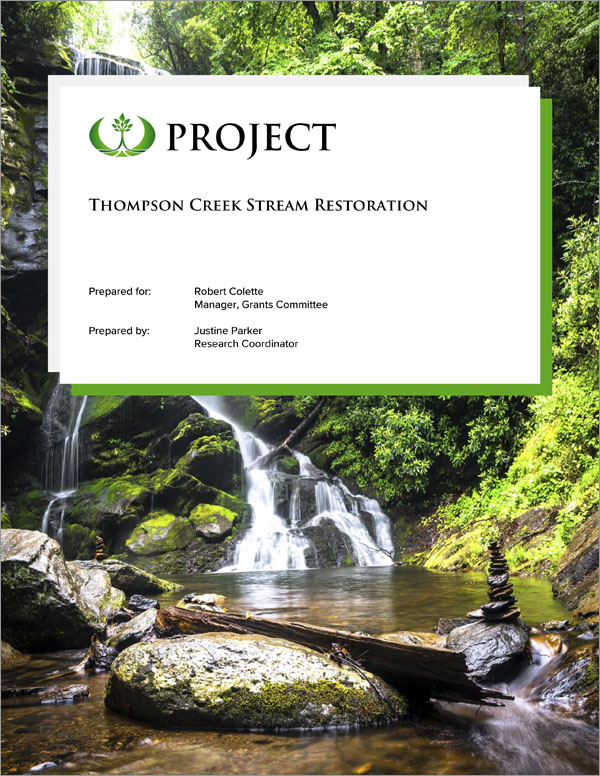
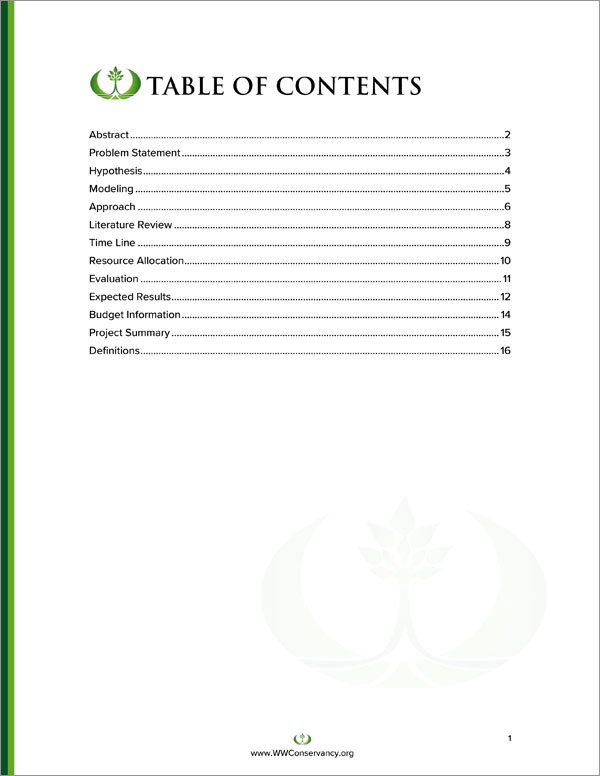
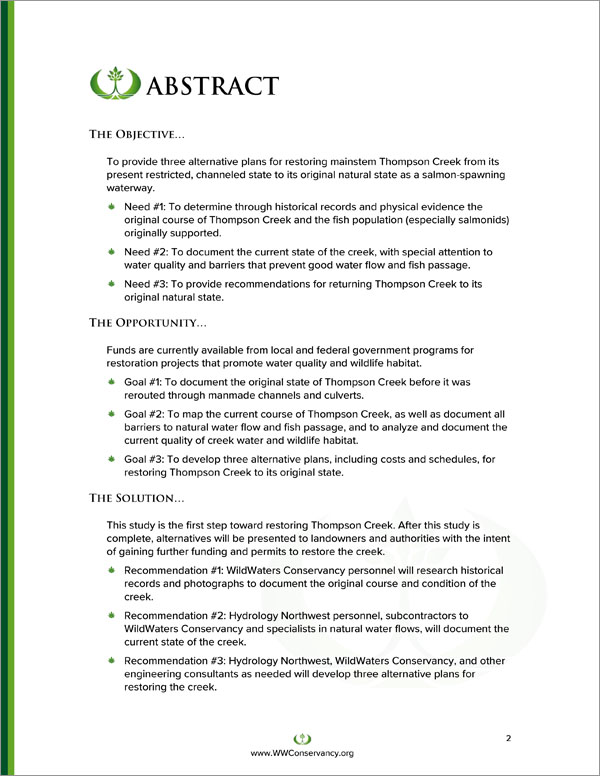
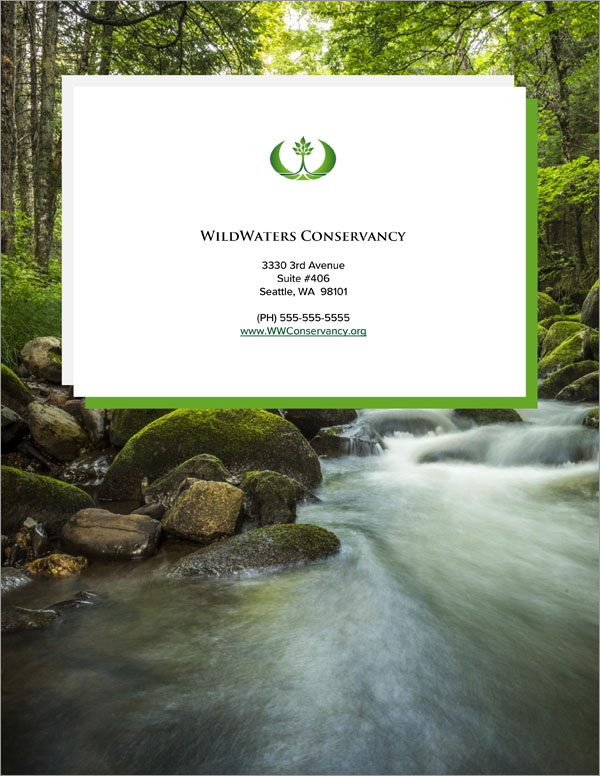
1. Get a Proposal Pack such as Outdoors #5.
This sample was created using the design theme Proposal Pack Outdoors #5. You can recreate this same sample using any of our Proposal Pack design themes and have it customized for your business.
We include this Research Sample Proposal in PDF and editable Word format chapters that can be customized using the included Wizard software.
To create your customized proposal using your logo and colors, get Proposal Pack for Any Business. We include this sample in every Proposal Pack.
2. Download and install after ordering.
Once you have ordered and downloaded your Proposal Pack you will have all the content you need to get started.
3. Set up the included Wizard software.
While the Wizard software makes the process more efficient, you can manually assemble your version of this sample using the content provided and just a Word processor.
4. Import the Quick Start layout titled 'Research Sample Proposal'.
The included Proposal Pack Wizard software makes creating a customized version of this document speedy and efficient. The sample content is in Word format documents, so you can also use the sample text without using our Wizard software.
This is a good example to follow for anyone writing a research proposal.
Anyone writing a research proposal or grant funding request proposal.
5. Customize the template with your information.
You can customize the layout with different chapters, change the order of chapters, import your content and information, change the visual design, edit the text, and more. You have complete control over customizing this sample.
Research Sample Proposal
Thompson Creek Stream Restoration
Please find enclosed a proposal from WildWaters Conservancy to study the feasibility of restoring Thompson Creek in Orcas County to its original watercourse and natural condition in order to promote spawning by salmonid species. During the early part of the Twentieth Century, Thompson Creek was the primary spawning ground for thousands of fish within Orcas County. This helped to develop salmon and trout fishing into major industries within Washington State. However, changes to the watercourse and water quality have damaged the creek to the point that it is now a nearly sterile and stagnant body of water.
WildWaters Conservancy has expertise in the study and rehabilitation of streams, with a special emphasis on fish spawning habitats. We have an extensive track record of successfully creating and protecting natural stream habitats and restoring native fish populations. We are requesting funding of $44,800.00 for this study, which includes development of three alternative plans for restoring the creek.
After approval of a specific plan, we will seek funding for the actual restoration of Thompson Creek. With a special emphasis on fish spawning habitats. We have an extensive track record of successfully creating and protecting natural stream habitats and restoring native fish populations.
Development of three alternative plans for restoring the creek. After approval of a specific plan, we will seek funding for the actual restoration of Thompson Creek.
The Objective
To provide three alternative plans for restoring mainstem Thompson Creek from its present restricted, channeled state to its original natural state as a salmon spawning waterway. To determine through historical records and physical evidence the original course of Thompson Creek and the fish population especially salmonids originally supported. To document the current state of the creek, with special attention to water quality and barriers that prevent good water flow and fish passage.
To provide recommendations for returning Thompson Creek to its original natural state.
The Opportunity
Funds are currently available from local and federal government programs for restoration projects that promote water quality and wildlife habitat. To document the original state of Thompson Creek before it was rerouted through manmade channels and culverts. To map the current course of Thompson Creek, as well as document all barriers to natural water flow and fish passage, and to analyze and document the current quality of creek water and wildlife habitat.
To develop three alternative plans, including costs and schedules, for restoring Thompson Creek to its original state.
The Solution
This study is the first step toward restoring Thompson Creek. After this study is complete, alternatives will be presented to landowners and authorities with the intent of gaining further funding and permits to restore the creek. WildWaters Conservancy personnel will research historical records and photographs to document the original course and condition of the creek.
Hydrology Northwest personnel, subcontractors to WildWaters Conservancy and specialists in natural water flows, will document the current state of the creek. Hydrology Northwest, WildWaters Conservancy, and other engineering consultants as needed will develop three alternative plans for restoring the creek. We have identified the following issue to be investigated. Can Thompson Creek be returned to its original natural channel and healthy state for use as a fish spawning stream.
In 1932, Thompson Creek was a healthy, natural watercourse in which thousands of salmon and sea going trout spawned each year. Since that time, Thompson Creek has been redirected from its natural course through culverts and concrete lined ditches. In places, the creek's natural flow has been diverted for crop irrigation or dammed to create ponds for livestock. The surrounding landscape has been modified in ways that have not benefited the creek, water quality has deteriorated, and many impediments to fish passage now exist, preventing spawning fish from returning.
For the health of the creek, the community, and the environment in general, we want to determine what must be done to return the creek to its natural state and create three alternative plans toward achieving that goal. At this moment, government grants are available for projects to restore fish spawning streams to natural conditions, so timely completion of this study is crucial as a first step toward rehabilitation of the creek. For purposes of this study, our working hypothesis is. It is desirable and possible to restore Thompson Creek to its original natural course and condition to promote water quality and healthy habitat for fish and other wildlife.
Many changes have been made to the creek over the years, including confining its waters to manmade channels, funneling it through culverts, damming it and diverting it for various uses. Our goal is to present alternatives for restoring it to its original natural condition, or as close to that as is practical. The study described within this proposal is the first part of the restoration project—developing a plan for restoration. Part II would be the actual restoration.
The WildWaters Conservancy team and consultants Hydrology Northwest will use accepted scientific models to perform their analyses. The Thompson Creek watershed will be divided into basins, with boundaries delineated by a topographic map with 1 foot contour intervals developed from LIDAR data and field verified by Conservancy personnel or consultants. Data for each basin will be input to the Western Washington Hydrologic Model WWHM4 Pro Version , which is a continuous hydrologic model that develops runoff time series for a 50 year period of rainfall record. This model generates statistical reports for several hydrologic parameters, including peak flow rates for estimated return periods, flow durations, low flow periods, annual runoff volumes and other data useful in evaluating and designing the proposed channel and related channel improvements.
The model will be used to explore potential strategies to promote healthy water flows within the creek. The channel hydraulics of Thompson Creek will be evaluated using the Corps of Engineers HEC­RAS model Version 4.0 U.S. Army Corps of Engineers, 2002; U.S. Army Corps of Engineers, 2008. The geometry for the existing channel will be based on the LIDAR topography.
The geometry for the proposed modifications to the stream channel will be based on the LIDAR topography and grading plans for the restored sections of creek. Model inputs for existing culverts will be based on field measurements obtained by WildWaters Conservancy. The HEC RAS model will be used to compute 100 year water surface elevations in the existing creek, and to design representative cross sections of the proposed channel under steady state flow conditions.
Hydrology Northwest consultants will also use this model to calculate flow velocities and depths for peak flow rates of various return periods. To complete the restoration study, WildWaters Conservancy and its consultants will carry out the following tasks. WildWaters Conservancy research personnel will gather and study all historical documents and photographs to determine the original state and location of mainstem Thompson Creek, as well as collecting and analyzing all available records about seasonal changes to creek levels and other variables that may affect water and wildlife.
Historical documents, including maps, aerial photographs, and landowner records, are maintained by the county. Records of scheduled analyses and surveys are maintained by state water quality and wildlife agencies. These may be supplemented by landowner accounts and photographs when provided by interested parties.
Concurrently with the historical study, personnel from Hydrology Northwest, consultants to WildWaters Conservancy, will document the current state of Thompson Creek. An accurate map of the creek will be created, noting all topographical features within 100 feet of the creek, as well as all property boundaries, roads, culverts, diversions, dams, and all inflows and outflows to and from the main creek channel. Hydrology Northwest will conduct water sampling and soil sampling of the creek area to determine current water quality and to document the geology of the area.
Piezometers will be constructed and studied to determine porosity and normal water levels within the soil. WildWaters Conservancy biologists will analyze current fish populations and document existing conditions that affect fish and other wildlife. Electrofishers will be used to locate fish within the stream. All fish will be identified and documented, as well as all fish indicators, such as redds and fish carcasses.
NativeNW Botany, consultants to WildWaters Conservancy, will document all plants within the stream corridor. Botanists will group plants into three categories, natural, introduced, and invasive species. After existing conditions have been documented, all WildWaters project personnel and consultants will develop three alternative plans for restoring Thompson Creek as close as possible to its original natural condition.
Estimates of costs and approximate schedules will be included with each alternative. WildWaters Conservancy will present the final report to the funding board and to all interested parties, and will solicit opinions for the most practical alternative. At this point, the legal permission of individual landowners to move the creek channel or change planting patterns must be secured.
After all interested parties have agreed on a course of action, the plan for restoring the creek will be presented to authorities and funding agencies to secure the necessary permits and funding to accomplish the restoration of Thompson Creek. Currently, funds are available for such a rehabilitation project, so time is of the essence to reserve this money for the restoration. Similar stream restoration projects have been undertaken, analyzed, and documented.
The following is a list of published studies of such projects. Returning ThunderArm Creek to Nature – Professional Hydrologist Journal, Volume 43. This study documents the process and results of restoring a Rocky Mountain stream channel heavily damaged by logging, mining, and livestock grazing.
From Concrete Tunnels to Cascading Waterfalls North American Stream Magazine, Volume 92. This study details each step in the intensive process of 'daylighting' a steam that had been channeled underground for decades within the city limits of Chicago. Can This Creek Be Saved. North American Stream Magazine, Volume 93.
Of particular interest in this study is the description of grading the surrounding topography to increase water flows into a nearly stagnant water course in Alberta, Canada. Salmon Comeback Story – Wild and Successful Projects, Volume 10. This scholarly article details steps taken to rehabilitate a Washington State stream and restore its salmonid spawning populations.
Information gleaned from these and other publications will assist us in this project. WildWaters Conservancy also plans to document our Thompson Creek restoration project for possible publication in an appropriate journal. Key project dates are outlined below.
Dates are "best guess" estimates predicted by projections into the future after receipt of project approval and funding. Dates may be affected by weather and availability of equipment and personnel. Reviews of various project components will take place during the course of the project as other tasks are in progress.
See the Evaluation page for more information. WildWaters Conservancy and its consultants, Hydrology Northwest and NativeNW Botany, have sufficient personnel, expertise, and equipment to carry out this study. Resources will be allocated as follows. Historical research – Two WildWaters Conservancy researchers Juan Ortiz, Leah O'Bannon will be assigned to locate, collect, and analyze all available documents regarding Thompson Creek.
These will include but are not limited to land use permits, maps, aerial photographs, water and well surveys and analyses, and precipitation statistics. Mapping – A survey team consisting of three experienced WildWaters Conservancy personnel Rosanne Lee, Penn Crawford, Sam Umbach will physically survey the creek area, noting corrections to current topographical maps and marking all culverts, dams, weirs, and diversions to or from the main creek channel. Standard survey equipment and GPS tracking devices owned by WildWaters Conservancy will be used.
Water and soil sampling Wildlife documentation – WildWaters Conservancy personnel are trained to conduct standard water and soil sample tests, as well as to document fish and other species present. Two teams of two scientists Wendy Marshall, Debora Polly, George Prowess, Martin Garr will conduct these tests. Standard water and soil sample testing kits and electrofishers owned by WildWaters Conservancy will be used.
Vegetation documentation – WildWaters Conservancy botany consultants NativeNW Botany will document all plantings within 100 feet of the creek channel. As a subcontractor to WildWaters Conservancy, NativeNW Botany will conduct its work in whatever way it deems necessary for a set fee and according to a fixed schedule. Stream flow measurements and hydraulic modeling – Hydrology Northwest will conduct stream flow measurements, analyze historical information presented, and conduct hydraulic modeling to predict flows within Thompson Creek, both as it exists and within alternatives presented at the end of this study.
Report of conclusions and recommendations – WildWaters Conservancy and Hydrology Northwest teams will collaborate to write a final report with three alternatives for stream restoration. Production and distribution of report – WildWaters Conservancy production expert Janine Winston will edit, format, copy, and distribute the final report. A professional copy service such as Advanced Digital Copy Company will be used to copy and assemble the report. WildWaters Conservancy reserves the right to substitute other qualified personnel for the above assignments if needed.
In order to ensure the effectiveness of our methodology and to determine the validity of our conclusions and recommendations, the following evaluation plan will be used. A committee composed of the following will review our research during our project. State Wild Waters Commission Advisors.
U.S. Fish and Wildlife Advisors. Orcas County land use specialists. Data gathered and conclusions made will be reviewed for the following components of the project. Historical data gathered and summarized Review by county land use specialists.
Map results – Review by county land use specialists. Water and soil test data – Review by State Waters Commission and USFW advisors. Fish and wildlife and vegetation identifications and lists – Review by State Waters Commission and USFW advisors.
Recommendations for returning Thompson Creek to its natural state – All parties listed above
Comments and suggestions by all reviewers will be taken into account and corrections and or additions made to the study report before the report is finalized. See the Timeline page for approximate dates of reviews and final report. The final report of this stream restoration study will include the following results.
A map and historical evidence of the original location and condition of Thompson Creek. This provides us with a specific and detailed goal for our restoration project. A detailed map of the current position of Thompson Creek, with descriptions and precise locations of all impediments within the Thompson Creek watershed. This provides with an accurate starting point for the project, as well as describing all challenges we must conquer to succeed in our goal of restoring the creek to its original channel.
This information will be shared with appropriate authorities for use in making future maps. Lists of all fish and other wildlife currently found within the creek channel. We need to protect all the existing wildlife during the course of the restoration project, as well as improving habitat for future generations of wildlife.
This information will be shared with the appropriate fish and wildlife authorities to provide an accurate description of existing species and numbers. A list of all plants found within 100 feet of the stream channel. This will provide us with a good understanding of beneficial plants to protect, as well as invasive plants to remove during the course of the project.
This information will be shared with appropriate county and state authorities to provide an accurate description of existing vegetation in the area. Statistics from all water and soil samples. These samples show pollutants and general conditions of the stream area.
This information will be shared with appropriate county and state authorities to provide an accurate description of existing conditions in the area. Predictions of hydrology and other modeling programs. All inputs and outputs of the modeling programs we use will be described in detail.
Three alternative plans for restoring Thompson Creek as close as possible to its original healthy state. Our teams will collaborate and create three alternative plans for restoring Thompson Creek as close as possible to its original healthy state. These plans will vary in costs and methodology of restoration efforts. Some details of results may vary as well.
The resulting final report will be distributed to the funding group, interested landowners, and state and county authorities for their edification and consideration. After completing the research and recommendations phase of the project, we hope to receive the necessary permits and funding to accomplish the actual creek restoration. Following is a summary of our budget estimates for this research project.
Note that estimates may change if more than ninety days elapses between submission of this proposal and project approval and receipt of funding. Note that this review fee consists of donations of $2000 each to the three organizations who have contributed reviewers, not a fee for actual time spent. The goals of this research study are to document the historical location and condition of Thompson Creek.
This defines the goal which we will try to achieve with restoration. To document the current location and condition of Thompson Creek. This will include documentation of water and surrounding soil conditions, impediments to flow and fish passage, and a survey of all wildlife and vegetation within and surrounding the creek. To develop three alternative plans for restoration.
Plans will vary in solutions and costs, giving the funding agency and affected parties alternatives from which to choose. The recommendation for this proposal is to approve this study plan and deliver requested funding of $44,800.00 as quickly as possible. Currently funds are available from local and national governments to restore fish spawning waterways to natural conditions. These funds will only be available for 18 more months.
To apply for these funds, an approved and permitted action plan is required. We want to complete our study as quickly as possible to acquire the approval of governing agencies for a restoration plan, and then secure additional funds to complete the actual restoration. This appendix contains the definitions for special terms used in this proposal. The following terms may not be known by the general public.
Electrofisher – A battery powered device that employs an electric current to attract and immobilize fish for easy capture. LIDAR– LIght Detection And Ranging – A system using lasers to measure distances. Mainstem – The primary channel of a stream. Piezometer – An instrument for measuring pressure, especially hydrostatic pressure.
Redd – Spawning ground or nest of a fish. Salmonid – Any of the family Salmonidae of bony fishes with three vertebrae upturned, such as salmon and trout. Weir– A structure used to raise the level of a river or stream but allow for overflow, also called a lowhead dam.
 What Our Clients Say
What Our Clients SayRunning a non-profit is hard enough. With the help of the Proposal Pack it allowed us the template we needed to help get our proposal off to a successful start! The professional look I wanted was already created no need to reinvent the wheel just use what was already there. The Proposal Kit folks already knew what would work and it did for us!"
Executive Director
Who’s Positive
There are thousands of proposal topics to choose from in Proposal Pack. This sample uses the following set of Proposal Pack topics: Cover Letter, Title Page, Table of Contents, Problem Statement, Abstract, Expected Results, Hypothesis, Modeling, Approach, Resource Allocation, Time Line, Literature Review, Evaluation, Budget Information, Project Summary, Definitions, Back Page.
The following related samples are also included in Proposal Pack:
- Non-technical proposal
- Project pitch proposal
- Non-government grant, non-profit, NGO proposal
- Nature, environmental proposal
- Research, science proposal
- Many other types of proposals
Out of the over 501 Proposal Packs available these designs are also popular for this type of proposal and this sample proposal is also included in every Proposal Pack:
Photo Design Proposal Packs
 Proposal Pack Aqua #5
Proposal Pack Aqua #5 Proposal Pack Aqua #7
Proposal Pack Aqua #7 Proposal Pack Business #20
Proposal Pack Business #20 Proposal Pack Computers #5
Proposal Pack Computers #5 Proposal Pack Nature #8
Proposal Pack Nature #8Line Art Design Proposal Packs
 Proposal Pack Aqua #1
Proposal Pack Aqua #1 Proposal Pack Nature #2
Proposal Pack Nature #2 Proposal Pack Nature #5
Proposal Pack Nature #5 4.7 stars, based on 841 reviews
4.7 stars, based on 841 reviews Ian Lauder has been helping businesses write their proposals and contracts for two decades. Ian is the owner and founder of Proposal Kit, one of the original sources of business proposal and contract software products started in 1997.
Ian Lauder has been helping businesses write their proposals and contracts for two decades. Ian is the owner and founder of Proposal Kit, one of the original sources of business proposal and contract software products started in 1997.By Ian Lauder
 Published by Proposal Kit, Inc.
Published by Proposal Kit, Inc.Related Article



 Cart
Cart
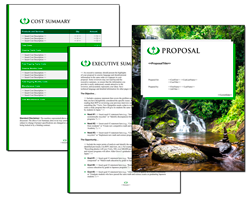
 Facebook
Facebook YouTube
YouTube X
X Search Site
Search Site